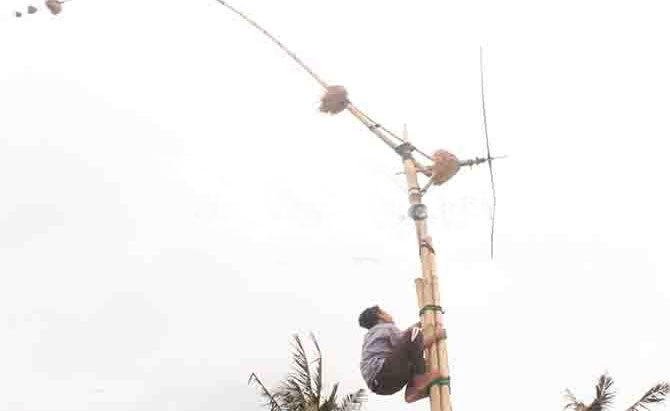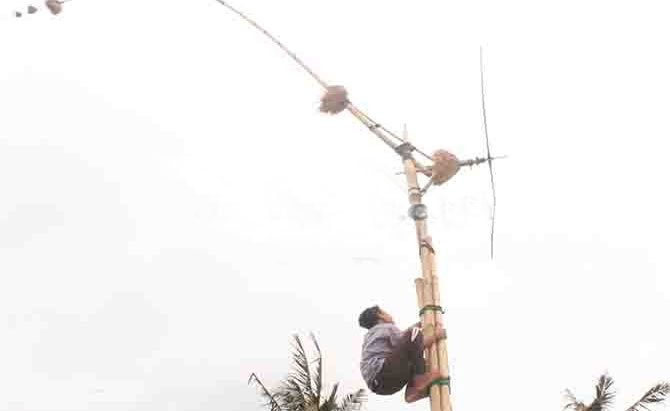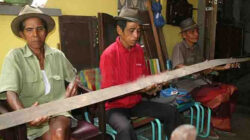Warga Oseng dikenal sebagai masyarakat agraris yang hingga kini masih menampakkan tradisi masa lalunya. Salah satu tradisi itu adalah panjer kiling. Hingga kini, salah satu warisan tradisi arsitektur agraris tersebut masih berkembang di kalangan masyarakat.
Panjer kiling merupakan tradisi kearifan lokal yang masih bertahan dan diwariskan secara turun-temurun hingga sekarang. Di dalam bahasa Oseng, manjer atau panjer artinya ’penyangga yang terbuat dari batang bambu besar’.
Manjer kiling maksudnya mendirikan kincir angin dengan penyangga yang terbuat dari bambu besar. Manjer kiling merupakan tradisi masyarakat Oseng dengan mendirikan kincir angin di tengah sawah.
Kiling terbuat dari bilah kayu yang dipasang pada batang bambu yang tinggi. Kiling menimbulkan suara gemuruh jika tertiup angin. Alat ini digunakan untuk mengusir burung di tengah sawah.
Abdul Rifai, 62, warga Dusun Kemiren Barat, Desa Kemiren mengatakan, jika gambaran status sosial dan ekonomi seorang warga Oseng bisa disimak dari kilingnya. Warga Oseng khususnya yang tinggal di Desa Kemiren kaya akan persawahan yang membentang luas.
Mereka yang tergolong kaya atau terpandang, memiliki kiling dalam ukuran besar dan ditempatkan pada posisi yang tinggi. ”Biasanya kiling dengan ukuran paling besar ditempatkan di rumah yang besar juga. Hal tersebut menandakan status sosial si pemilik,” ujar Rifai.
Saat kiling dipasang di atas panjer dan tertiup angin, kiling itu terus berputar. Semakin kencang angin bertiup semakin keras berputarnya. Sehingga menghasilkan suara yang mendesing. Suara desingannya mencapai radius dua kilometer jika panjang baling-balingnya lebih dari satu meter.
Kiling itu terbuat dari bahan kayu, bentuknya khas dimiliki masyarakat Oseng. Kincir angin khas Oseng itu ditopang penyangga yang disebut panjeran. Terbuat dari batang bambu besar.
Panjer kiling didirikan di area persawahan dengan tujuan untuk mengusir burung yang menjadi hama padi. Pendirian kiling di tengah sawah sangat bermanfaat bagi para petani dan berpengaruh pada hasil produksi padi untuk masyarakat. Dengan adanya panjer kiling, tugas petani untuk menjaga sawah menjadi lebih mudah karena tidak banyak padi yang dirusak oleh burung.
”Karena hasil panen yang bagus maka yang dihasilkan semakin banyak dan meningkatkan kesejahteraan warga dalam perekonomiannya,” ucap pria yang juga penyuka barang antik tersebut.
Bagian-bagian kiling memiliki arti tersendiri. Kedua sisi kiling itu dibuat berbeda. Bagian atas dibuat panjang dan sedikit membengkok dan menghasilkan suara saat di pasang di atas panjer. Ini melambangkan kaum laki-laki atau biasa disebut kiling lanang.
Sedangkan bagian bawah dibuat pendek dan lurus yang melambangkan kaum perempuan atau biasa di sebut kiling wadon. Bagian kiling yang panjang yang melambangkan kaum laki-laki merupakan pusat sumber bunyi kiling yang paling keras.
Hal ini menunjukkan adanya perbedaan antara kaum laki-laki dan perempuan. Di mana kaum laki-laki lebih kuat dari pada kaum perempuan. Kaum laki-laki harus bisa membimbing keluarga dengan perkataan dan tindakan yang benar. Sedangkan kaum perempuan menjadi penyeimbang keluarga serta harus patuh terhadap pemimpin keluarga.
Selain itu, kiling yang diberi pembatas bagian tengah sehingga terlihat menjadi dua bagian juga melambangkan dua kalimat syahadat. Hal itu menunjukkan segi kereligiusan warga sebagai rasa berterima kasih kepada Tuhan Yang Maha Esa atas rezeki yang diberikan melalui persawahan mereka.
Pada bagian panjer yang terbuat dari bambu besar memiliki tujuan tersendiri. Panjer merupakan penyangga yang melambangkan kekokohan. Bambu merupakan jenis kayu yang kuat dan banyak manfaatnya.
Hal ini melukiskan kuatnya rasa kekeluargaan warga Desa Kemiren dalam segala hal terutama gotong-royong. Selain itu, panjer terdiri atas satu pohon pinang dan empat bambu. Penyangga atau panjer yang menggunakan batang berjumlah lima tersebut melambangkan rukun Islam.
Aspek sosial dan religi sangat mendalam dalam panjer kiling. Hal ini bertujuan agar dalam pendirian kiling itu dapat memberikan manfaat dan mendatangkan keberuntungan karena proses pendiriannya tidaklah mudah dan semuanya melambangkan kebaikan.
Tradisi manjer kiling merupakan cara yang sudah membudaya pada warga Oseng. Tradisi manjer killing ini dikhususkan untuk pertanian. Sehingga tradisi ini tidak terpisah dari tradisi lainnya, melainkan merupakan satu kesatuan dengan beberapa kesenian lain di Banyuwangi seperti kesenian seblang bakungan, kebo-keboan Alas Malang, dan juga gending tarian gandrung.
Kesenian-kesenian tersebut mengangkat tema yang pada umumnya merupakan wujud syukur atas hasil pertanian dan perkebunan.(radar)








